Biological Concepts — Lab 3 online
BASIC GENETICS
|
Instructions: Study all the visual information in this online lab, plus the accompanying explanations. Be prepared to answer a few "check-in" questions to show that you were paying attention. |


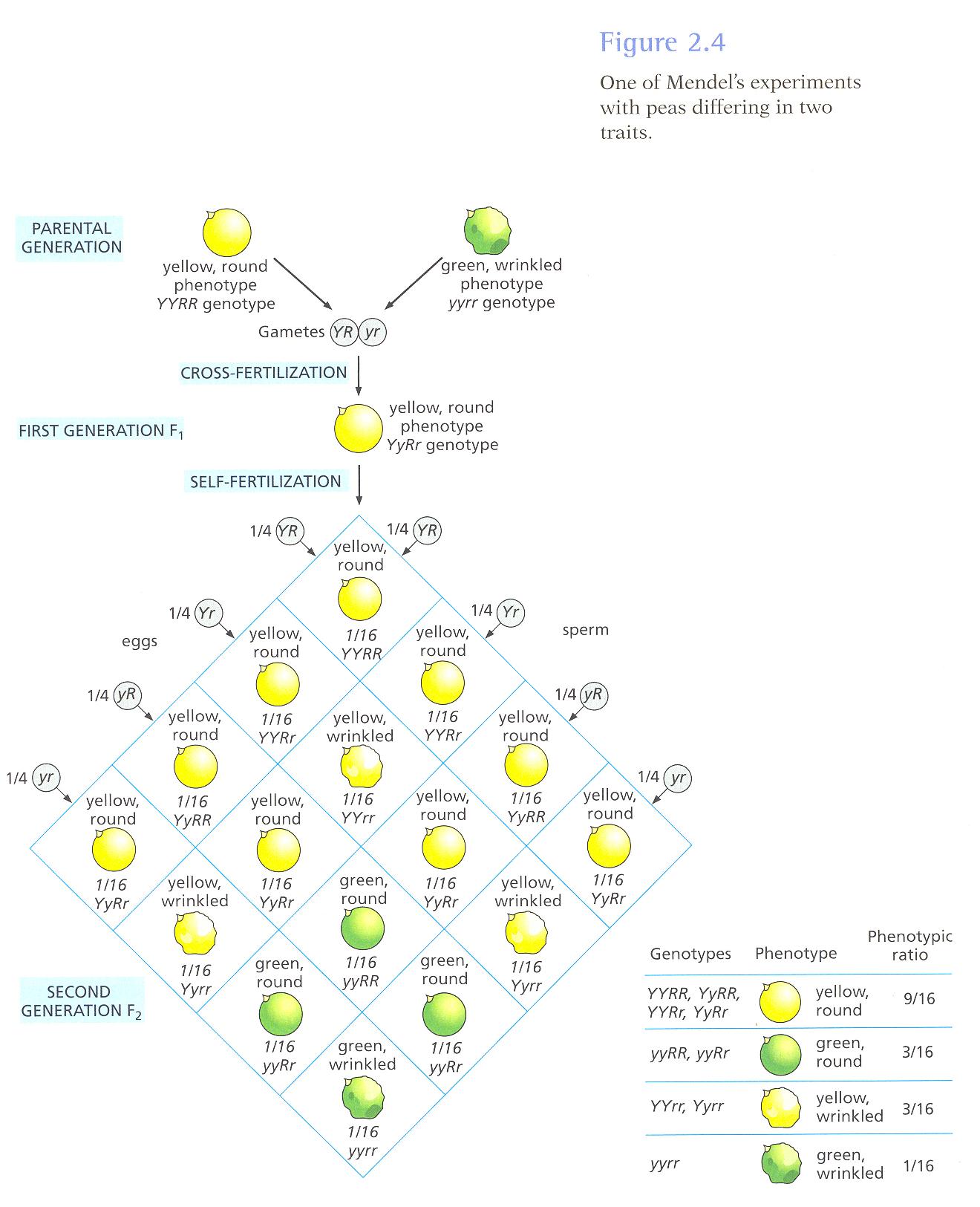
EXERCISES
In fruit flies, vestigial wings (v) are recessive to normal wings (V, dominant). Also, ebony body (e) is recessive to gray body (E). Show a cross between a female heterozygous for both traits and a vestigial-winged male heterozygous for body color. What fraction of the offspring will share the father's phenotype for both traits? |
Male: vvEe x Female: VvEe
| Eggs: Sperm: | VE | Ve | vE | ve |
| vE | VvEe normal wings gray | VvEe normal wings gray | vvEE vestigial wings gray | vvEe vestigial wings gray |
| ve | VvEe normal wings gray | Vvee normal wings ebony | vvEe vestigial wings gray | vvee vestigial wings ebony |
|
PRACTICE YOURSELF-- GENETICS PROBLEMS to work out on your own: 1. In fruit flies, hairy body (h) is recessive to normal body (H), and vestigial wings (v) are recessive to normal wings (V). If a hairy-bodied male, heterozygous for wing shape is crossed with a vestigial-winged female, homozygous for normal body, what fraction of their offspring will have vestigial wings? What fraction will resemble the father in both traits? Will any offspring share the mother's genotype? 2. A male fruit fly, heterozygous for both vestigial wings and hairy body is crossed with a hairy-bodied female heterozygous for wing shape. What fraction of their offspring will have vestigial wings? Normal wings? What fraction will have hairy bodies? Normal bodies? 3. In garden peas (see above), a plant with violet-red flowers and inflated pods is crossed with a a white-flowered plant with pinched pods. If the offspring all have inflated pods but half have white flowers and half have red-violet flowers, what are the genotypes of the parents? 4. Each of the offspring from problem 3 is crossed (separately) with a white-flowered plant with pinched pods. What results would you predict? (Answers are below, near the end, but please try to work out the problems on your own first.) |
PEDIGREES
AUTOSOMAL DOMINANT TRAITS
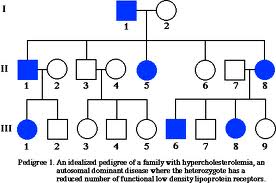
In all these pedigrees, circles are female and squares are male. Horizontal lines are marriages (matings),
and the vertical lines descending from the marriage lines are the offspring of the marriage.
Filled-in symbols show individuals affected by the phenotypic trait being shown.

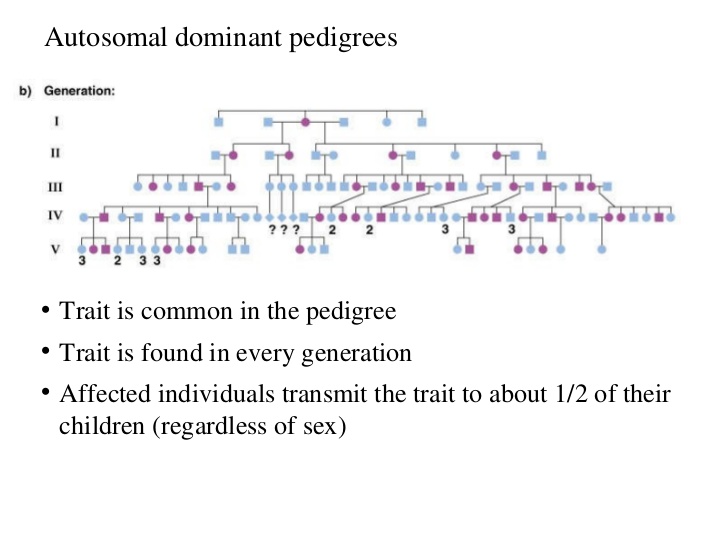


AUTOSOMAL RECESSIVE TRAITS


Notice that, for autosomal recessive traits, the chances of being homozygous for the recessive trait is greatly
increased if matings take place between relatives ("consanguineous matings"), as in this example.
Try to determine which individuals were almost certainly heterozygous in this pedigree.
Inheritance of cystic fibrosis:

DOMINANT OR RECESSIVE?


The simplest interpretations may not always apply. Here is a common type of exception.
This pedigree does not fit the pattern of recessive inheritance. It ALMOST fits the pattern for
dominant inheritance, except for individual II-1 (first individual in row II). The best explanation
for this pedigree is dominant inheritance with "incomplete penetrance", meaning that individual II-1
probably had the dominant allele but was not exposed to whatever environmental variable was needed
to express the phenotype. For example, if a person inherits a trait that makes them susceptible to a
disease like tuberculosis, they still won't get the disease unless they are exposed to the tuberculosis bacteria.
SEX-LINKED RECESSIVE INHERITANCE
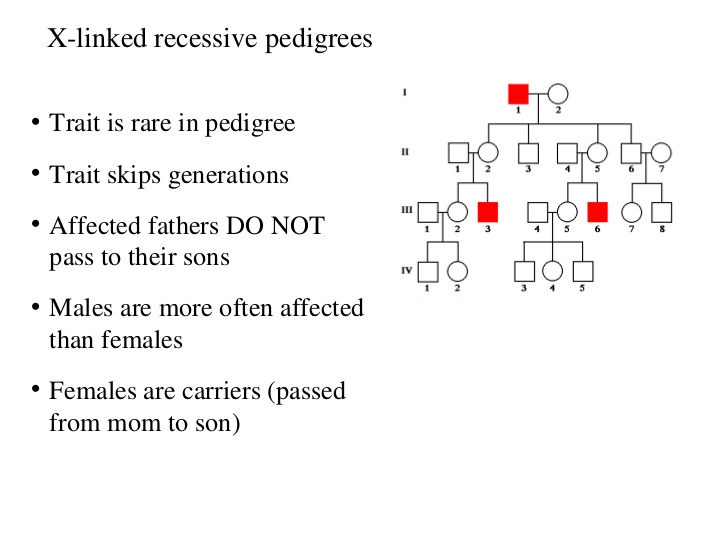
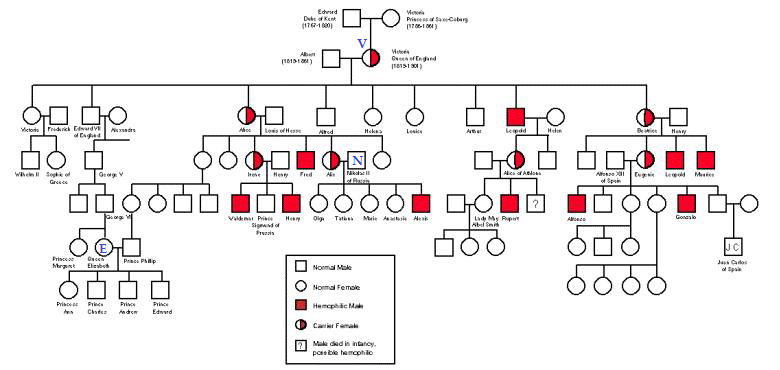
A FAMOUS PEDIGREE: Inheritance of hemophilia (inability of the blood to clot) in the royal families of Europe.
V is Queen Victoria; E is the current Queen Elizabeth II; N is Nicholas II, the last Czar of Russia, whose son
Alexis (heir to the throne) had hemophilia. Many historians believe that the boy's hemophilia made his parents
greatly fearful of his life (if he were to fall and scrape himself, he might bleed to death), and this allowed
Rasputin (who claimed to have magical powers) to have undue influence over royal affairs,
a circumstance which hastened the Bolshevik revolution of 1917.
DNA and GENE EXPRESSION

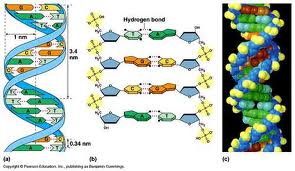
MOLECULAR STRUCTURE OF DNA (detail below)


DNA REPLICATION



· · · • • • • • · · ·
ANSWERS to the "PRACTICE YOURSELF" genetics problems given above: